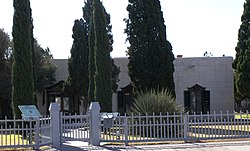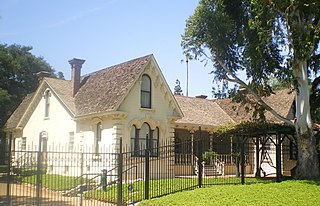
The Workman and Temple Family Homestead Museum is a historic house museum located at 15415 East Don Julian Road in City of Industry, California, that features the homes and private cemetery that belonged to the pioneer Workman-Temple family.

Starr Family Home State Historic Site is a 3.1-acre (1.3 ha) historical site operated by the Texas Historical Commission in downtown Marshall, Texas. It was listed on the National Register of Historic Places in 1979. The museum was made a Recorded Texas Historic Landmark in 1986. On January 1, 2008, the site was transferred from the Texas Parks and Wildlife Department to the Texas Historical Commission.

Hueco Tanks is an area of low mountains and historic site in El Paso County, Texas, in the United States. It is located in a high-altitude desert basin between the Franklin Mountains to the west and the Hueco Mountains to the east. Hueco is a Spanish word meaning hollows and refers to the many water-holding depressions in the boulders and rock faces throughout the region. Due to the unique concentration of historic artifacts, plants and wildlife, the site is under protection of Texas law; it is a crime to remove, alter, or destroy them.

Sunset Heights is a historic area in El Paso, Texas; which has existed since the latter part of the 1890s. Many wealthy residents have had their houses and mansions built on this hill. Although some buildings have been renovated to their former glory, many have been neglected and have deteriorated. An organization, the Sunset Heights Improvement Association helps neighbors on a fixed income to manage home maintenance and also sponsors an annual tour.

McKinney Falls State Park is a state park in Austin, Texas, United States at the confluence of Onion Creek and Williamson Creek. It is administered by the Texas Parks and Wildlife Department. The park opened on April 15, 1976 and is named after Thomas F. McKinney, a businessman, race horse breeder and rancher, who owned and lived on the land in the mid-to-late 19th century. The park is part of the El Camino Real de los Tejas National Historic Trail.

The Ríos-Caledonia Adobe is a historic adobe house in San Miguel, California. Built in 1835 by Petronilo Ríos, the adobe is a California Historical Landmark. Today, the Ríos-Caledonia Adobe is open to the public as a house museum and library.

The Leonis Adobe is a historic adobe located in what is now Calabasas, California. One of the oldest surviving private residences in Los Angeles County and one of the oldest surviving buildings in the San Fernando Valley, it was built in 1844 and occupied by the wealthy rancher Miguel Leonis until his death. Afterward, the property was the subject of a legal dispute between his common law wife Espiritu Chijulla, heirs, and a daughter born out of wedlock; the dispute lasted more than 15 years in the courts. In 1961, the adobe had fallen victim to vandalism, and its owner applied for a permit to raze the structure and erect a supermarket in its place. Preservationists succeeded in having the adobe declared Los Angeles Historic-Cultural Monument #1 in 1962, saving it from the wrecking ball at the last minute. It was listed on the National Register of Historic Places in 1975.

The Sam Rayburn House Museum is a historic house museum at 890 West Texas State Highway 56 in Bonham, Fannin, Texas. Built in 1916, it was home to Sam Rayburn (1882-1961), a famously effective Speaker of the United States House of Representatives. It was declared a National Historic Landmark in 1976. Since 1972, it has been operated as a museum and state historic site by the Texas Historical Commission.
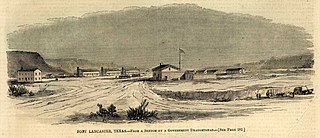
Fort Lancaster is a former United States Army installation located near Sheffield, Texas. The fort was established in 1855 on the San Antonio–El Paso Road to protect migrants moving toward California through Texas. The US Army occupied Fort Lancaster until Texas seceded from the United States in March 1861 and were replaced at the fort by forces loyal to the Confederate States of America. The Confederate Army held the fort from November 1861 until April 1862, when it was again abandoned and then burned.

The Ysleta Mission, located in the Ysleta del Sur Pueblo within the municipality of El Paso, Texas, is recognized as the oldest continuously operated parish in the State of Texas. The Ysleta community is also recognized as the oldest in Texas and claims to have the oldest continuously cultivated plot of land in the United States.

The Goodman–LeGrand house and museum is located at 624 North Broadway, in the city of Tyler, county of Smith in the U.S. state of Texas. It was added to the National Register of Historic Places listings in Smith County in 1976, and has been a Recorded Texas Historic Landmark since 1962. The Daughters of the American Revolution designated it an Historic Site in 2010.

Casa Navarro is a historic site in San Antonio, Bexar County, in the U.S. state of Texas. The original house complex was the residence of Texas patriot José Antonio Navarro (1795–1871), a rancher, merchant, leading advocate for Tejano rights, and one of only two native-born Texans to sign the Texas Declaration of Independence. Navarro first bought the property, about 1.5 acres, in 1832. The limestone, caliche block, and adobe structures were built c. 1832–1855, and Navarro moved onto the property soon after.

The Fort Leaton State Historic Site is located on Farm to Market Road 170, in Presidio County in the U.S. state of Texas. The original adobe structure was a private residence dating back to the early 19th century. It was purchased in 1848 by Benjamin Leaton, who adapted it as a fortress. Fort Leaton was the Presidio County original seat of government. Through murders, financial difficulties and abandonment, the structure changed hands numerous times. In 1967, it was deeded to the state of Texas and opened to the public in 1978 as a Texas State Historic Site. It was added to the National Register of Historic Places listings in Presidio County, Texas on June 18, 1973.

The Yturri–Edmunds Historic Site is an historic site in San Antonio, Texas. The house is listed on the National Register of Historic Places listings in Bexar County, Texas. The homestead and mill were designated a Recorded Texas Historic Landmark in 1966.

The Presidio Chapel of San Elizario was built in 1877 at the same place where an earlier Mexican chapel stood. The building is located in the central square of San Elizario, 17.5 miles south-southeast of El Paso. It was listed on the National Register of Historic Places in 1972. It is an example of the Spanish Colonial style.

The Woman's Club of El Paso was founded in the late nineteenth century, and during that time was the only woman's organization in El Paso, Texas. The Woman's Club also allowed women in El Paso to become involved in community service and activism. The building which is the home for the club is located on 1400 N. Mesa Drive, and was erected in 1916. The club, now a non-profit organization, traces its official origins back to 1894, and continues to provide an "educational and cultural center for its members." The building is registered in the National Register of Historic Places.
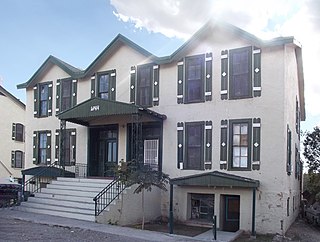
Old Fort Bliss are a pair of two-story adobe buildings in El Paso, Texas. They were built in the 1850s, and designed in the Victorian architectural style. They were army barracks and later remodelled into apartment buildings. The structure has been listed on the National Register of Historic Places since February 23, 1972. In 2017, the structure was endangered.

The House at 912 Magoffin Avenue is a historic house in El Paso, Texas. It was built first built as a two-story house in 1898 where a one-story house once stood. It was redesigned in 1903–1905 in the Queen Anne architectural style. It was the home of Margaret Conerton, an Irish immigrant who died in the house in 1908. By 1935, it belonged to the Stubbs family. It has been listed on the National Register of Historic Places since June 23, 2003.
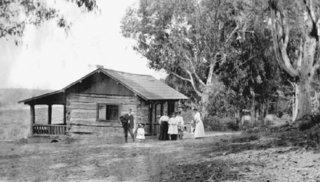
Murphy's Barn, also known as the Murphy Barn/Powers Studio, is a historic building that was built in 1846, by Matthew M. Murphey in Carmel-by-the-Sea, California. The structure is recognized as an important American period farm building and the oldest remaining artist's studio in Carmel. It was nominated by the Carmel City Council as a historical building and an application was submitted to the California Register of Historical Resources on July 1, 2002.
Leola Isabel Freeman was an American artist and gallery owner. She specialized in landscapes, portraiture, and Mexican genre paintings. The bulk of her career took place in El Paso, Texas.
